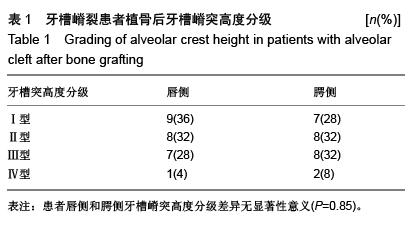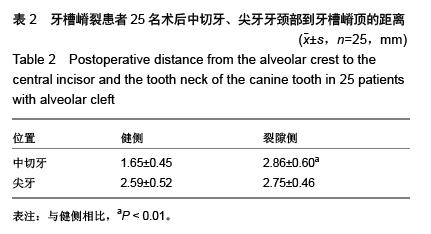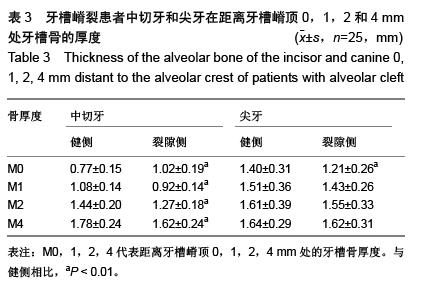| [1] Perdikogianni H, Papaioannou W, Nakou M, et al. Periodontal and microbiological parameters in children and adolescents with cleft lip and /or palate. Int J Paediatr Dent. 2009;19(6): 455-467. [2] Boyne PJ, Sands NR. Secondary bone grafting of residual alveolar and palatal clefts. J Oral Surg. 1972;30(2):87-92.[3] 张岱尊,周容,肖文林,等.锥形束CT对牙槽突裂植骨术后成骨效果的评价[J].中华口腔医学杂志,2014,49(6):352-356.[4] Suomalainen A, Åberg T, Rautio J, et al. Cone beam computed tomography in the assessment of alveolar bone grafting in children with unilateral cleft lip and palate. Eur J Orthod. 2014;36(5):603-611.[5] Felstead AM, Deacon S, Revington PJ. The outcome for secondary alveolar bone grafting in the South West UK region post-CSAG. Cleft Palate Craniofac J. 2010;47(4):359-362. [6] Witherow H, Cox S, Jones E, et al. A new scale to assess radiographic success of secondary alveolar bone grafts. Cleft Palate Craniofac J. 2002;39(3):255-260.[7] Nair R, Deguchi TS, Li X, et al. Quantitative analysis of the maxilla and the mandible in hyper- and hypodivergent skeletal Class II pattern. Orthod Craniofac Res. 2009; 12(1):9-13. [8] Katsumata A, Nojiri M, Fujishita M, et al. Condylar head remodeling following mandibular setback osteotomy for prognathism: a comparative study of different imaging modalities. Oral Surg Oral Med Oral Pathol Oral Radiol Endod. 2006;101(4):505-514. [9] Celikoglu M, Halicioglu K, Buyuk SK, et al. Condylar and ramal vertical asymmetry in adolescent patients with cleft lip and palate evaluated with cone-beam computed tomography. Am J Orthod Dentofacial Orthop. 2013;144(5): 691-697.[10] Celikoglu M, Nur M, Kilkis D, et al. Mesiodistal tooth dimensions and anterior and overall Bolton ratios evaluated by cone beam computed tomography. Aust Orthod J. 2013; 29(2):153-158.[11] Hynes PJ, Earley MJ. Assessment of secondary alveolar bone grafting using a modification of the Bergland grading system. Br J Plast Surg. 2003;56(7):630-636.[12] Wehrbein H, Fuhrmann RA, Diedrich PR. Periodontal conditions after facial root tipping and palatal root torque of incisors. Am J Orthod Dentofacial Orthop. 1994;106(5):455-462.[13] Wehrbein H, Bauer W, Diedrich P. Mandibular incisors, alveolar bone, and symphysis after orthodontic treatment. A retrospective study. Am J Orthod Dentofacial Orthop. 1996; 110(3):239-246.[14] Wehrbein H, Fuhrmann RA, Diedrich PR. Periodontal conditions after facial root tipping and palatal root torque of incisors. Am J Orthod Dentofacial Orthop. 1994;106(5): 455-462. [15] Aziz T, Flores-Mir C. A systematic review of the association between appliance-induced labial movement of mandibular incisors and gingival recession. Aust Orthod J. 2011;27(1): 33-39. [16] Parker RJ, Harris EF. Directions of orthodontic tooth movements associated with external apical root resorption of the maxillary central incisor. Am J Orthod Dentofacial Orthop. 1998;114(6):677-683. [17] Lupi JE, Handelman CS, Sadowsky C. Prevalence and severity of apical root resorption and alveolar bone loss in orthodontically treated adults. Am J Orthod Dentofacial Orthop. 1996;109(1):28-37. [18] Kook YA, Kim G, Kim Y. Comparison of alveolar bone loss around incisors in normal occlusion samples and surgical skeletal class III patients. Angle Orthod. 2012;82(4): 645-652. [19] Handelman CS. The anterior alveolus: its importance in limiting orthodontic treatment and its influence on the occurrence of iatrogenic sequelae. Angle Orthod. 1996; 66(2):95-109; discussion 109-110. [20] Nahm KY, Kang JH, Moon SC, et al. Alveolar bone loss around incisors in Class I bidentoalveolar protrusion patients: a retrospective three-dimensional cone beam CT study. Dentomaxillofac Radiol. 2012;41(6):481-488.[21] Feichtinger M, Zemann W, Mossböck R, et al. Three-dimensional evaluation of secondary alveolar bone grafting using a 3D- navigation system based on computed tomography: a two-year follow-up. Br J Oral Maxillofac Surg. 2008;46(4):278-282. [22] Feichtinger M, Mossböck R, Kärcher H. Assessment of bone resorption after secondary alveolar bone grafting using three-dimensional computed tomography: a three-year study. Cleft Palate Craniofac J. 2007;44(2):142-148. [23] Arctander K, Kolbenstvedt A, Aaløkken TM, et al. Computed tomography of alveolar bone grafts 20 years after repair of unilateral cleft lip and palate. Scand J Plast Reconstr Surg Hand Surg. 2005;39(1):11-14. [24] Meazzini MC, Capasso E, Morabito A, et al. Comparison of growth results in patients with unilateral cleft lip and palate after early secondary gingivoalveoloplasty and secondary bone grafting: 20 years follow up. Scand J Plast Reconstr Surg Hand Surg. 2008;42(6):290-295.[25] Agarwal R, Parihar A, Mandhani PA, et al. Three-dimensional computed tomographic analysis of the maxilla in unilateral cleft lip and palate: implications for rhinoplasty. J Craniofac Surg. 2012;23(5):1338-1342.[26] van der Meij Aj, Baart JA, Prahl-Andersen B, et al. Outcome of bone grafting in relation to cleft width in unilateral cleft lip and palate patients. Oral Surg Oral Med Oral Pathol Oral Radiol Endod. 2003;96(1):19-25.[27] Alonso N, Risso GH, Denadai R, et al. Effect of maxillary alveolar reconstruction on nasal symmetry of cleft lip and palate patients: a study comparing iliac crest bone graft and recombinant human bone morphogenetic protein-2. J Plast Reconstr Aesthet Surg. 2014;67(9):1201-1208.[28] Honma K, Kobayashi T, Nakajima T, et al. Computed tomographic evaluation of bone formation after secondary bone grafting of alveolar clefts. J Oral Maxillofac Surg. 1999; 57(10):1209-1213.[29] Wen Y, Shi B, Yang Z. The mechanical force analysis of cleft maxillary three dimensional finite element models after alveolar bone graft. Sheng Wu Yi Xue Gong Cheng Xue Za Zhi. 2006;23(6):1253-1257.[30] Jia Y, Fu M, Ma L. The comparison of two-dimensional and three-dimensional methods in the evaluation of the secondary alveolar bone grafting. Zhonghua Kou Qiang Yi Xue Za Zhi. 2002;37(3):194-196.[31] Kawakami S, Hiura K, Yokozeki M, et al. Longitudinal evaluation of secondary bone grafting into the alveolar cleft. Cleft Palate Craniofac J. 2003;40(6):569-576.[32] Feichtinger M, Mossböck R, Kärcher H. Assessment of bone resorption after secondary alveolar bone grafting using three-dimensional computed tomography: a three-year study. Cleft Palate Craniofac J. 2007;44(2):142-148. [33] Feichtinger M, Mossböck R, Kärcher H. Evaluation of bone volume following bone grafting in patients with unilateral clefts of lip, alveolus and palate using a CT-guided three-dimensional navigation system. J Craniomaxillofac Surg. 2006;34(3):144-149. [34] Kim KR, Kim S, Baek SH. Change in grafted secondary alveolar bone in patients with UCLP and UCLA. A three-dimensional computed tomography study. Angle Orthod. 2008;78(4):631-640.[35] Van der Meij AJ, Baart JA, Prahl-Andersen B, et al. Bone volume after secondary bone grafting in unilateral and bilateral clefts determined by computed tomography scans. Oral Surg Oral Med Oral Pathol Oral Radiol Endod. 2001; 92(2):136-141. [36] Tai CC, Sutherland IS, McFadden L. Prospective analysis of secondary alveolar bone grafting using computed tomography. J Oral Maxillofac Surg. 2000;58(11):1241-1249; discussion 1250. [37] Rychlik D, Wójcicki P. Bone graft healing in alveolar osteoplasty in patients with unilateral lip, alveolar process, and palate clefts. J Craniofac Surg. 2012;23(1):118-123. [38] Feichtinger M, Zemann W, Mossböck R, et al. Three-dimensional evaluation of secondary alveolar bone grafting using a 3D- navigation system based on computed tomography: a two-year follow-up. Br J Oral Maxillofac Surg. 2008;46(4):278-282. [39] Oberoi S, Gill P, Chigurupati R, et al. Three-dimensional assessment of the eruption path of the canine in individuals with bone-grafted alveolar clefts using cone beam computed tomography. Cleft Palate Craniofac J. 2010;47(5):507-512. [40] Oberoi S, Chigurupati R, Gill P, et al. Volumetric assessment of secondary alveolar bone grafting using cone beam computed tomography. Cleft Palate Craniofac J. 2009;46(5): 503-511.[41] Ozawa T, Omura S, Fukuyama E, et al. Factors influencing secondary alveolar bone grafting in cleft lip and palate patients: prospective analysis using CT image analyzer. Cleft Palate Craniofac J. 2007;44(3):286-291. [42] Schultze-Mosgau S, Nkenke E, Schlegel AK, et al. Analysis of bone resorption after secondary alveolar cleft bone grafts before and after canine eruption in connection with orthodontic gap closure or prosthodontic treatment. J Oral Maxillofac Surg. 2003;61(11):1245-1248. [43] Trindade IK, Mazzottini R, Silva Filho OG, et al. Long-term radiographic assessment of secondary alveolar bone grafting outcomes in patients with alveolar clefts. Oral Surg Oral Med Oral Pathol Oral Radiol Endod. 2005;100(3):271-277. [44] Dado DV, Rosenstein SW, Alder ME, et al. Long-term assessment of early alveolar bone grafts using three-dimensional computer-assisted tomography: a pilot study. Plast Reconstr Surg. 1997;99(7):1840-1845. [45] McCanny CM, Roberts-Harry DP. A comparison of two different bone-harvesting techniques for secondary alveolar bone grafting in patients with cleft lip and palate. Cleft Palate Craniofac J. 1998;35(5):442-446. [46] Santiago PE, Grayson BH, Cutting CB, et al. Reduced need for alveolar bone grafting by presurgical orthopedics and primary gingivoperiosteoplasty. Cleft Palate Craniofac J. 1998;35(1):77-80. [47] da Silva Filho OG, Teles SG, Ozawa TO, et al. Secondary bone graft and eruption of the permanent canine in patients with alveolar clefts: literature review and case report. Angle Orthod. 2000;70(2):174-178.[48] 杨超,石冰,刘坤,等.腭侧入路牙槽突裂植骨术的初步应用与评价[J].华西口腔医学杂志,2013,31(1):30-33. |
.jpg)



.jpg)